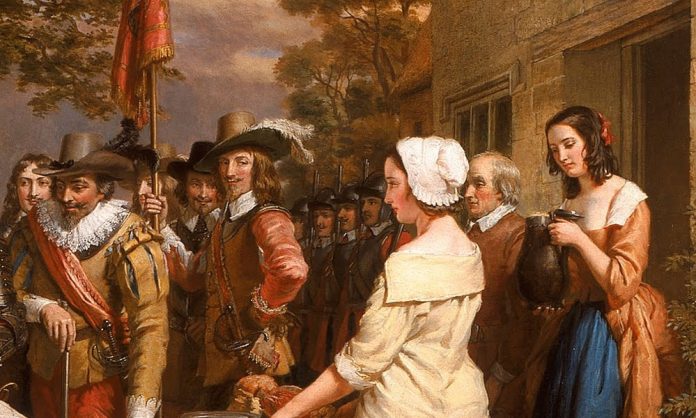
Many of these structures were as expected including a former Quaker’s meeting house and garden features, many of which could be traced back through historical map regression. The work also made an unexpected discovery of a grave dating to the time of the English Civil War (1642-1651) which contained a skeleton believed to be that of a young female.
Removal of the garden soil from the site exposed the grave, which unusually had not been placed in consecrated ground or other church land. Excavation of the grave revealed the skeleton of a carefully-placed individual, who appeared to have been wrapped in a shroud fastened by pins. The contorted position of the burial may also suggest that the lady had been buried while still in rigor mortis, possibly indicating she died while sleeping or in her bed.
Closing the eyes of the dead

A Charles I silver shilling dated to 1640 or 1641 and silver half groat dating to 1635-1636 were found by the individual’s head, possibly having been placed over either her eyes or mouth. The tradition of placing coins over the eyes of the deceased date back to ancient Greek and Roman times, when the inclusion of coins was believed to be payment for the ferryman who would take a person’s soul to the afterlife. This was not a universal practice among Christian burials and seems to be here more a local and cultural, rather than a religious, custom. The closing of the eyes in Britain is cited as being more likely due simply to guard against rigor mortis setting in while they are still open, the eyelids being one of the first parts to be affected. However, this was often combined with a superstition that being looked at by a corpse could be a bad omen. To aid this, pennies were sometimes placed on eyelids to keep them shut. The value of the coins would indicate that this person was from a reasonably wealthy background.
The burial was found alone among later 18th to 19th Century rubbish pits, garden features and animal burials. Loggan’s map of Oxford in 1675 indicates the area was a back garden of a large tenement that fronted onto St Giles’. With the exception of the medieval boundary wall and ditch no other features from the 17th century were identified during the excavation.
Wild theories abound
The discovery has been accompanied by much speculation in the local press, appearing on the front page of the Oxford Mail, on the mystery of who she was and why she had been buried in a garden during the 17th century. Wild theories developed in the press including suggestions of modern foul play, witches being buried alive or murder of a civil war prostitute. However, the care taken over the burial suggests that the woman had not been considered an outcast or had been buried in haste.
A more reasonable answer

It is possible, however, that her death coincides with a series of outbreaks of typhus or plague. A typhus epidemic, called ‘morbus campestris’, (camp fever) was recorded in 1643, and plagues of 1644-45 during the siege of Oxford by parliamentary forces may have made more formal burial difficult. The overcrowding, insanitary conditions recorded in the town during this period were as a result of the billeting of royalist officers, soldiers and their families and were highlighted as a potential cause for the outbreaks.
Thomas Willis, a physician who treated the Oxford victims of the outbreak, described its effect on the garrison “…..his [ie the King’s] Foot being a great many together in straightened lodgings when they had filled all places with nastiness and filth, and stinking odours…fell sick many of them together, as it were in files; at length the fever reaching farther than the soldiery…”.
Edward Greaves, another Oxford army physician, published a leaflet entitled ‘Morbus Epidemius’ in which he described the disease as “a Malignant and contagious fever”. The first sign of this disease was “a great weakness without any manifest cause”, strong men in a short time were rendered unable to walk, could hardly stand unaided and frequently fainted. The second sign was “a quick weak, creeping pulse, sometimes intermittent” and other symptoms included fever, vertigo, vomiting or severe chills. Purple spots appeared on at least half of those affected.

Not all people that caught the disease died from the condition. However, it was highly contagious and appeared to have spread quickly throughout the town. Greave’s leaflet suggests that most people recovered from the disease, possible to help reassure the population. Parliamentary spies, though, reported that as many as c.40 died a week in July 1643 within the town. The burial records for the local parish church (St Mary Magdalen) indicate that over 200 individuals were buried during the typhus outbreak, potential overwhelming the church graveyard. During many of these outbreaks the local parish churches would have also been closed in order to help prevent the spread of the disease.
The post-excavation work is just starting and the remains will be analysed further by OA’s Heritage Burial Service team and the context of the burial investigated through historical records. It is also hoped that the results of pioneering pathogen DNA analysis on the bones may be able to shed more light on whether this burial was an unfortunate victim of one these outbreaks.
OA specialists hope to uncover a sufficiently interesting story in order to publish the results of this work in the journal, Oxoniensia. “Ultimately our aim is to try to identify whom the Lady of St Cross College was and why she was buried within the garden.” they confirmed.
Source: Oxford Archaeology http://oxfordarchaeology.com/news


